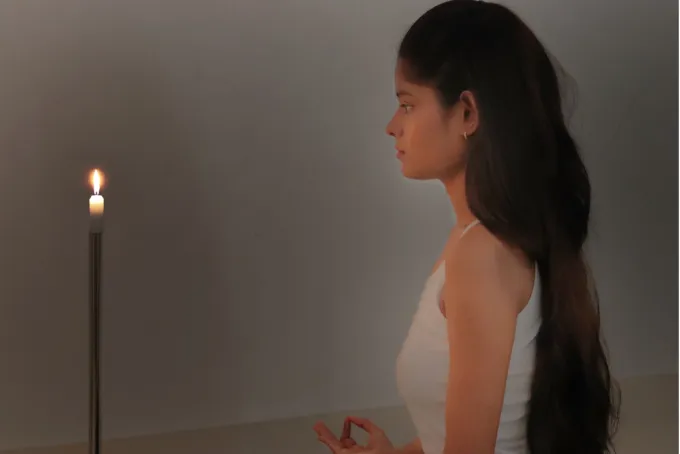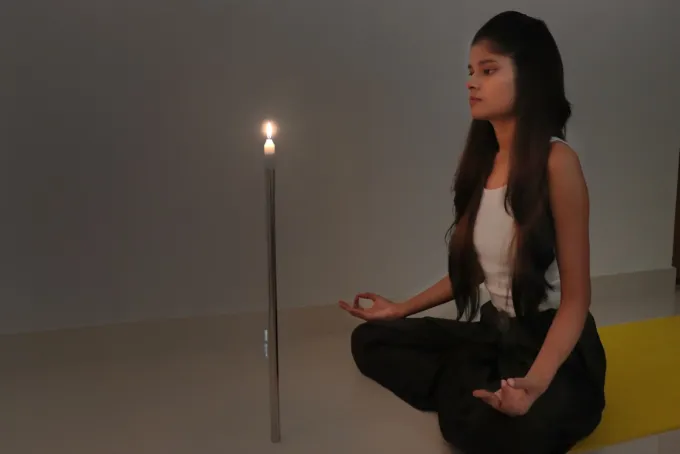What Is Trataka Yoga’s main goal has always been to calm the mind’s cognitive processes. Yogis employed a variety of meditation techniques to stop these thinking patterns from fluctuating.
However, when we are aware of where our minds are occupied the most and make an effort to reduce that time, meditation becomes more comfortable and calm.
According to scientific research, 50% of our thoughts are always thinking about “what we see,” or our eyesight. The reason why our eyes close naturally as we slumber is to calm our minds.
That is how “vision” plays a part in yoga and we learn about Trataka meditation.
What to Understand from Trataka?
The word “Trataka” derives from Sanskrit and Мeaning “to gaze” or “to look.” Therefore, it advises fixating on a single spot in order to maintain attention and control oscillation.
Yoga comprises six branches, out of which Hatha Yoga is one of the most powerful and popular branches. Its literal meaning is “force” and hence includes physical techniques of Yoga.
Trataka is a technique of hatha yoga which comes under the category of Shatkarma/Shatkriyas (six techniques) in the purification of the frontal mind region. It is a science of vision.
Shatkarmas are a set of cleansing procedures and purification of the body via yogic means. “Trataka” is one of those six actions.
What to Focus on? Where to Look?
There can be multiple points to look upon and objects to focus on Тrataka. It can be
- Flame of a candle,
- Dot on the wall,
- Flower, sky, rock or mountain,
- An object of devotion or worship, deity or idol, Shiva Linga, mandala or yantras, a chakra, the symbol Om,
- Own image in mirror or shadow and
- Even the sun and the moon.
It is important to choose the Тrataka symbol carefully. That portion of your inner self can be awakened by the object of your concentration. If you concentrate on the picture of the Hindu goddess Kali, you might even manifest her, but if you haven’t learned to get past that, you might also be horrified by her terrifying appearance.
To do Trataka, a steady flame light, such as a candle, is thought to be the best, most useful, and safest option—at least until the teacher or guru suggests otherwise. Good vision and ideas are drawn to the flame by acting as a magnet for the eyes and mind. After that, the mind is able to retain beautiful images.
Types of Trataka
Trataka is of three types:
- External Trataka or “Antaranga”
- Middle Trataka or
- Internal Trataka or “Bahiranga”
1. External Trataka
External Тrataka involves keeping the eyes open while concentrating on certain stimuli until tears start to form in the eyes. The “candle flame” Тrataka is the most widely used and practiced choice of gazing object (described below).
It is a preparatory exercise for beginners who wants to deepen in meditation practice. It also builds Dharna (concentration), 6th in 8 limbs of yoga, in the practitioner.
2. Middle Trataka
No external object is selected for gaze in Madhya or middle Тrataka; instead, attention is directed to the middle of the brows (Shambhavi Mudra) and the tip of the nose (Nashik Agra Drishti). Another way to practice it is to fix your eyes on a black dot that is printed on white paper.
Madhya Trataka helps people become more awake and cultivates awareness in the Ajna Chakra.
3. Internal Trataka
When the exterior Тrataka technique is perfected, the practitioner is ready to engage in interior Тrataka, which is the practice of gazing into nothingness. In this Тrataka, the practitioner closes their eyes and focuses their attention on an internally imagined object.
The center of the brows, the heart, or the belly button is the most frequently pictured internal objects in internal Тrataka.
Techniques for Performing Trataka
Based on focusing on external or internal objects, Тrataka techniques are of the following types.
1. Candle Flame Trataka
It’s the type of external Тrataka. The steps of doing candle flame Тrataka are the following.

- Sit in a room that is dark and has little to no disturbance, such as bugs or drafts.
- A candle should be held in front at arm’s length, with the flame level with the eyes.
- Sit in a comfortable posture for meditation, e.g., Siddh-asana/ Siddha yoni asana
- Put your hands in the Gyan mudra or prana mudra and cross your knees.
- By closing your eyes, you may de-stress and relax your entire body.
- Prepare to hold a motionless position until the exercise is complete.
- Start looking at the candle as soon as you can see. The red tip of the candle should be the object of your gaze for the best gazing.
- Maintain the gaze as long as possible.
- Avoid blinking or putting strain on your eyes.
- When your eyes begin to moisten, stop.
2. Internal Trataka
The first steps are the same as in candle flame Trataka except that the opening of the eyes.
- Close your eyes and picture a symbol or a point of light, such as the moon—full or crescent, a flashing star, etc.
- Try to view that in a dark area and steadily focus on that.
With practice, the duration should be lengthened gradually. Throughout the process, you must watch and observe your thoughts, feelings, and emotions while attempting to maintain a fixed gaze. If the image shifts, bring it back to the center, where it was before, and keep looking at it until it vanishes. The afterimage should be steady and concentrate on the color you intended.
When to Practice Trataka?
The following are some ideal circumstances and times for maximizing the effects of your Trataka practice.
- Four to six o’clock in the morning after performing asana and pranayama. As in the morning, the mind is less fickle, and the eyes are more active, which can enhance Trataka practice.
- Trataka can be done at any time, however, it is thought to be most effective when done on an empty stomach.
- It facilitates profound mental exploration when performed late at night before sleeping and before chanting (Japa) or meditation.
- Simultaneously Mantra Japa should be done if you feel flooded with thoughts.
- When the focus becomes a challenge, visualize your breath moving in a straight line between the middle of your brow and the Ajna chakra (third eye chakra) at the back of your head.
Where Does the Trataka Act?
Trataka is believed to act on the “third eye.” It is the medium of bringing one.”
“Third eye” is a term very familiar to spiritual and meditative practices. It is a mystic and enigmatic concept of having an invisible eye located between the eyebrows on the forehead.
In the 7 Chakras, the third eye, or the inner eye is considered the gateway to enlightenment and a self-awakening state. It mediates our journey to higher consciousness.
With the use of Trataka, we can see farther than what the human eye can see. It is the capacity to perceive true potential as well as what might occur.
Thus, the Trataka exercise was developed to develop our higher wisdom and third-eye abilities. Trataka stimulates the psychic powers to strengthen the sixth sense, which helps to communicate with the mind and acquire confidence in daily life. It also opens this center of energy.
If we stick to tradition, this meditation approach enables a clear vision of the past, present, and future.
The Hatha Yoga Trataka Kriya develops and purifies the ocular muscles.
Eyes – Unveiling The Mind and The Soul
Your eyes need some time to adjust when you walk into a dark room. You can make accommodations in that case.
Visualize the same darkness, but not in a physical space, but rather only in your thoughts.
Fundamental darkness is a common occurrence that affects people. They are undecided and perplexed. They become disoriented in that mental maze and stray in search of some light.
One of the most crucial sense organs is said to be the eyes. For the perceptions of touch, smell, and taste, the stimulus must be closely approximated. However, the ability to see can be used from a distance. Eyes may be able to see so far that even our ears would be unable to hear a sound made at the same distance.
Remove the drapes and then the window panes in order to bring natural light into a space and allow for a clear view.
The same is true here; to engage in effective meditation, you must clear your mind of all unhelpful thoughts and erratic emotions. The eyes, which are also known as “windows of the soul,” provide natural, vivid light on the inner being.
Trataka is a technique that let us look into the mind & so on, the soul through the eyes.
Eyes and the Brain
According to the facts of human embryology, the development of the eyes begins two weeks after conception. Consequently, the link between the eyes and the brain starts early in utero.
The eyes serve as a conduit for mental communication with the outside world. As soon as the brain detects something, sensory impulses are delivered to it (old or new). Depending on how the brain interprets the information, motor impulses are sent.
Thus, there is a direct link between the eyes and the brain. When something is fully digested in the mind, it leaves an afterimage. When the eyes are exposed to numerous things, microsaccades or jerking movements become constant.
The mind becomes more alert and the restless scan stops if you keep your eyes motionless and concentrate on one thing. The brain’s total amount of distractions decreases. Both the thoughts and the body become still. If the vision is clear and sharp, it is simple to alter perceptions.
Thus, it is important to stop staring into space in order to induce mental quiet.
Mechanism of Trataka
Through focus, or “ekagrata,” the meditation method known as “Trataka” turns off the sensory information to the brain. You can get control of the sensory data and the brain activity is turned off.
As Trataka means to persistently look, the eyes are a crucial pathway to greater consciousness. Your mind can be controlled and kept from straying by integrating into the observation of an object.
How Trataka Works Through Eyes?
- The light enters the eyes, where it is converted into energy.
- An image developed on the retina at the rear of the eye during the moment of gazing.
- It travels along the optic nerve to the visual cortex, which controls your visual perception and is located in the occipital region of the brain.
- It stimulates the neurons, arouses the brain’s sleepy regions, and links it to the rest of conscious consciousness.
- Strengthening of the eye muscles and their relationship to the brain aid in improving both vision and concentrating ability. The mind relaxes when the focus is maintained on one subject at a time.
- As the same object continuously gazes, the mind is accustomed to that and stops its registration. This habituation diminishes attention to the external world.
- The pineal gland (third eye), which is stimulated by the energy entering the brain, transforms it into electromagnetic energy and distributes it to the various body organs.
- The sensory modalities are switched off through Trataka & the brain comes to a powerful form of rest. Heart rate and other organs slow down and rejuvenate themselves by restoring the Prana – life force.
Through this procedure, the area that often maintains its dominance is calmed, while dormant domains are given the opportunity to charge and awaken.
The mind is “shut off” and communication with the outside world is eliminated when we limit our consciousness to a single stimulus that remains constant.
Benefits of Trataka

Trataka teaches us the technique of exclusion, which requires us to concentrate solely on one item. The inner paths are accessible through this method, leading to a journey of self-realization where the lower and higher selves converge.
The Gheranda Samhita makes reference to a number of scriptures that discuss the advantages of Trataka. In addition to enhancing the spiritual self, Tataka has beneficial impacts on physiology and psychology in people.
Psychological Benefits
- Increases mental strength and the ability to focus intently.
- Removes Vrittis (bad thought patterns), which calms the mind and keeps it from straying.
- Aids in clearing the subconscious mind of buried thoughts, emotions, and unmet goals.
- Develops clairvoyance, telekinesis, and telepathy
- Increases intuitive understanding and offers a wise and outstanding vision.
- Increases willpower and is effective in treating depression
Physiological Benefits
- Cure all eye-related issues, such as headaches, eyestrain, long and short-sightedness, astigmatism, etc
- Eyes develop the ability to discern inner truth rather than just outward appearance.
- Channeling the nerve system’s activity in a single direction
- Lowers the heart rate and respiration rate
- Increases peripheral blood flow
- Sleep quality improves with Trataka practice.
Spiritual Benefits
- The practice of Trataka helps in attaining the Shambhavi Mudra. It further enables the practitioner to stimulate the third eye.
- The contemplative state of Dharana is attained by practitioners.
- Trataka practice helps in achieving a state of complete peacefulness.
- In Trataka, a rapt relationship develops with the supreme state of a cosmic self.
- Freedom from visual dominance is gained when the idea of “believing only what is seen” is abandoned.
- To reach the highest state of consciousness, practice Trataka.
Research on Trataka
Numerous studies have been conducted in the medical area to evaluate the effects of Trataka on human physiology and cognitive processes.
An investigation was done among the senior population of Goa, India, to see if Trataka affected their cognitive abilities. Participants in this study insisted on using relaxation techniques such as eye exercises, focus and defocus, chanting, breathing, and stillness.
The result suggests that Trataka is very useful in improving short-term memory, concentration, attention, and executive functions.
Concerning eye diseases, e.g., ametropia and presbyopia (similar), research was done on a total of 66 patients (132 eyes), recruited for the study. The results suggested moderate improvement in clarity of vision, contrast sensitivity, and fineness of objects.
The fact that a significant improvement was made with this inexpensive, non-pharmacological relaxing treatment was thought to be encouraging. Better outcomes can be attained when pharmacological therapies are paired with dietary and lifestyle changes.
Conclusion
By performing the beautiful technique of Tratka, you can attain complete calmness and peacefulness of mind with increased cognitive functions.
As a result, Trataka Kriya is a gem that is mentioned in numerous Yoga literature. Awakening the third eye, or inner eye of understanding, is a skill. This age-old method can serve as a ladder to the highest degree of awakening in the gloomy Kali-yuga, where everyone is consumed by their concerns and struggles to improve their lot in life. It can revive the spirit and facilitate the fusion of the higher and lower self.
You can obtain complete bliss and order the scattered and dispersed energy of the senses and emotions by regularly practicing Trataka.
Trataka teaches how to look past outward appearances in addition to improving concentration and focus. It sharpens your mind and enables you to gain knowledge and insight.





















